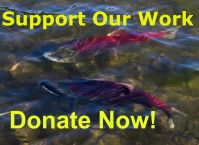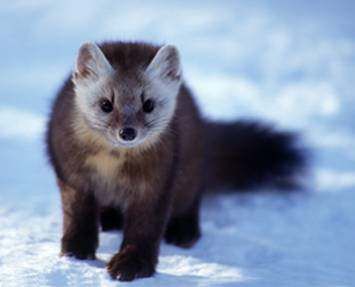SUMMARY
Anchorage Public Meeting on Proposed Roadless Rule Exemption
Nov. 6th, 2019
- US Forest Service (USFS) Alaska Roadless Coordinator/Project Contact:
Robin Dale
in Juneau
907-586-9344
rdale@fs.fed.us - Alaska Roadless Rulemaking project link: https://www.fs.usda.gov/project/?project=54511
- In January 2018, just about a month after Governor Mike Dunleavy was sworn into office, the State of Alaska petitioned to be exempt from the 2001 Roadless Rule.
- Final decision-making regarding which of the six alternatives will be chosen is in the hands of Secretary of Agriculture Sonny Perdue (from Georgia, who has a background in veterinary medicine and agriculture) https://www.usda.gov/our-agency/about-usda/our- secretary.
- Currently, there are two 60-day public comment periods going on, meaning that YOU can should submit TWO separate comments - one on the Draft Environmental Impact Statement (DEIS) and one on the proposed rule. Submit both to the addresses below.
- Both of these comment periods end on December 17th, 2019. This is the LAST CHANCE for the public to weigh in before a FINAL decision is made by Secretary Sonny Perdue.
Ways to comment:
- Web: http://www.fs.usda.gov/project/?project=54511
- Email: akroadlessrule@fs.fed.us
- Mail: USDA Forest Service, Attn: Alaska Roadless Rule, P.O. Box 21628, Juneau, Alaska 99802
Information highlighted by the public during the Anchorage meeting (abbreviations of public comments):
- "The proposed rule would likely harm fishing, ecotourism and recreation industries that make up the vast majority of the jobs and regional income in Southeast. There are already a lot of families leaving Southeast with people losing jobs and schools closing", according to a resident of Juneau.
- Only "0.7% of the region's economy is based on logging and timber", according to a comment made by an attorney from Trout Unlimited Alaska.
- Read this important article by Richard Peterson (President of Tlingit and Haida):
- An Anchorage resident referenced the important op-ed written by Central Council of Tlingit & Haida Indians President Richard Peterson: http://www.kinyradio.com/news/news-of-the-north/op-ed-respect-alaska-tribes-rights-on- the-tongass-question/
- The comment pointed out how six federally recognized tribal entities are engaged in the process, but are not being respected as sovereign governments, nor are they being compensated for their engagement (like a timber lobbying group and the state of Alaska are).
- None of the tribal government expressed the desire for Alternative 6, yet the USDA (under Perdue) "...has identified Alternative 6, which is a full exemption of the Roadless Rule, as the preferred alternative at this time."
- Another resident of Juneau pointed out that, "approximately 90% of the 144,000 public comments submitted during the scoping period indicated preference for keeping the Roadless Rule in place - at least to some extent..."
- "Alternative 6, the Roadless Rule exemption, would give the timber industry the opportunity to harvest some of the last remaining, really large (4'-10' diameter), rare, old growth trees in the Tongass...An additional 166,000 acres of old growth forest would be classified as harvestable, which would have global climate impacts", according to a former forester that worked in the Tongass NF.
- Currently, "46 million board feet are harvested from the Tongass per year on average", which several residents of Southeast brought up in their comments.
- That same forester mentioned, "trees do not develop old growth characteristics until they have been living for about 300 years." → "Old growth is NOT a renewable resource and the scientific community has come to an agreement that old growth is too valuable to be clear cut."
- A volunteer "watchdog" of public processes brought up that "there was no transcriber at this meeting to record the questions and comments," and, "this meeting, unlike other federal meetings, was not in downtown Anchorage. Instead, it was held in an obscure part of University of Alaska campus", near the residence halls. It was difficult to find. Still, about 50 people attended, and 100% of those who spoke up were opposed to the full exemption of the Roadless Rule.
- According to research done by Audubon Alaska, under Alternative 6, "at least 80% of the habitat for [several] native species of birds and mammals would be lost, including martens [photo by Larry Cowell] and goshawks [photo by Steve Garvie].
Background
- Department of Agriculture developed the Roadless Rule in 2001.
- According to USFS: "The 2001 Roadless Rule establishes prohibitions on road construction, road reconstruction, and timber harvesting on 58.5 million acres of inventoried roadless areas on National Forest System lands. The intent of the 2001 Roadless Rule is to provide lasting protection for inventoried roadless areas within the National Forest System in the context of multiple-use management."
- "99% of the Chugach National Forest and 55% of the Tongass National Forest (both in Alaska) are "inventoried roadless areas" (IRAs)", according to Robin Dale, USFS.
- "The Tongass National Forest is the largest National Forest in the country, making up about 80% of Southeast Alaska. The Tongass is nearly 17 million acres in size. In combination with British Columbia's Great Bear Rainforest immediately to the south, it encompasses the largest intact temperate rainforest on earth." Audubon Alaska
- "The Tongass is the only area of the National Forest System still implementing a logging program focused on clearcutting old growth." Crag Law Center
- Information from USDA summarized by the Center for Biological Diversity: There are two provisions regarding the Chugach National Forest in the proposed rule "that would authorize two types of changes to Inventoried Roadless Areas on the Chugach. First, after notice and a 30-day comment period, the provision would allow for "administrative corrections to boundaries" that are "limited to adjustments that remedy clerical errors, typographical errors, mapping errors, improvements in mapping technology, conformance to statutory or regulatory changes, or incorporation of changes due to land exchanges." Second, the regulation grants the Alaska Regional Forester authority to "issue modifications to the classifications and boundaries of an Inventoried Roadless Area after a 45-day public notice and opportunity to comment period."
The full range of options under the proposed rule (published by the USDA):
- Alternative 1 takes no action and would leave all of Alaska under the 2001 Roadless Rule, including the Tongass National Forest.
- Alternative 2 provides regulatory protection for the majority (89%) of key watersheds inside roadless areas and would convert 18,000 old-growth acres and 10,000 young-growth acres previously identified as unsuitable timber lands to suitable timber lands.
- Alternative 3 provides regulatory protections for all key watersheds inside and outside roadless areas, creates a community priority roadless designation that allows for recreational development and timber sales under 1 million board feet, and would convert 76,000 old-growth acres and 14,000 young-growth acres previously identified as unsuitable timber lands to suitable timber lands.
- Alternative 4 restricts harvest and road-building activities in scenic viewsheds and most (88%) key watersheds inside roadless areas and would convert 158,000 old-growth acres and 15,000 young-growth acres previously identified as unsuitable timber lands to suitable timber lands.
- Alternative 5 would remove 2.3 million acres from roadless area designation, protects some (59%) key watersheds, and would convert 165,000 old-growth acres and 17,000 young-growth acres previously identified as unsuitable timber lands to suitable timber lands.
- Alternative 6 (preferred) would exempt the Tongass National Forest from the 2001 Roadless Rule and is fully responsive to the State of Alaska's petition. The alternative would remove all 9.2 million acres of inventoried roadless acres and would convert 165,000 old-growth acres and 20,000 young-growth acres previously identified as unsuitable timber lands to suitable timber lands. Conservation of roadless values would be achieved through other means, including the Tongass Land Management Plan. This is specific to the Tongass National Forest. The Chugach National Forest would remain under the 2001 Roadless Rule.
If you have any questions, please email: eyak@redzone.org.


